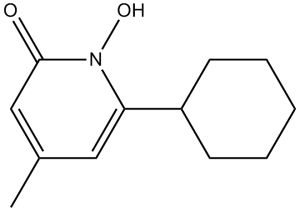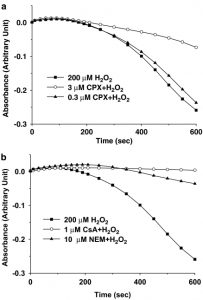This product is for research use only, not for human use. We do not sell to patients.

| Size | Price | Stock |
|---|---|---|
| 500mg | $250 | Check With Us |
| 1g | $400 | Check With Us |
| 5g | $1000 | Check With Us |
Cat #: V0186 CAS #: 29342-05-0 Purity ≥ 99%
Description: Ciclopirox (HOE-296; LACQUER; Penlac), a hydroxypyrimidine analog, is an potent, synthetic and broad-spectrum antifungal agent used for topical dermatologic treatment of superficial mycoses. It acts as an iron chelator and also inhibits the membrane transfer system by interrupting the Na+ K+ ATPase. Ciclopirox is currently being investigated as an alternative treatment to ketoconazole for seborrhoeic dermatitis.
Publications Citing InvivoChem Products
Product Promise

- Physicochemical and Storage Information
- Protocol
- Related Biological Data
- Stock Solution Preparation
- Quality Control Documentation
| Molecular Weight (MW) | 207.27 |
|---|---|
| Molecular Formula | C12H17NO2 |
| CAS No. | 29342-05-0 |
| Storage | -20℃ for 3 years in powder formr |
| -80℃ for 2 years in solvent | |
| Solubility In Vitro | DMSO: 42 mg/mL (202.6 mM)r |
| Water: <1 mg/mLr | |
| Ethanol: 42 mg/mL (202.6 mM) | |
| SMILES Code | CC1=CC(=O)N(C(=C1)C2CCCCC2)O |
| Synonyms | Ciclopirox; Penlac; Batrafen; Ciclopiroxum; Loprox; HOE 296; HOE296; HOE-296; Ciclopirox olamine |
| Protocol | In Vitro | In vitro activity: Ciclopirox olamine (CPX) is a lipophilic bidentate iron chelator that stabilizes HIF-1alpha under normoxic conditions at lower concentrations than other iron chelators, probably by inhibiting HIF-1alpha hydroxylation. Ciclopirox olamine (CPX)-induced HIF-1 mediates reporter gene activity and endogenous HIF-1 target gene expression, including elevation of transcription, mRNA, and protein levels of the vascular endothelial growth factor (VEGF). Ciclopirox inhibits growth of C. albicans yeast and hyphal cells in a dose-dependent manner. Ciclopirox blocks H2O2-induced mitochondrial injury by maintaining mitochondrial transmembrane potential (Deltapsim). Ciclopirox completely blocks H2O2-stimulated release of lactate dehydrogenase (a marker of cell death) and decreases in MTT reduction (a marker of mitochondrial function) in adenocarcinoma SK-HEP-1 cells. Ciclopirox effectively inhibits H2O2-induced mitochondrial permeability transition pore (MPTP) opening. Ciclopirox increases the MTP, maintained it high, and blocks the ATP depletion in glucose-deprived SIN-1-treated astrocytes. Ciclopirox protects astrocytes from peroxynitritecytotoxicity by attenuating peroxynitrite-induced mitochondrial dysfunction. Ciclopirox is a substituted pyridone antimycotic drug, unrelated to the imidazole derivatives and its topical application ensures maximum local bioavailability. Ciclopirox acts on fungi by inhibiting the intracellular uptake of essential substrates and ions and this probably acts on the Candida ability to express its adherence mechanisms. Cell Assay: Sabouraud glucose medium (2%) is used for cell culture growth, and RPMI 2% glucose medium and 2% Sabouraud glucose medium are used for MIC determinations. For cell culture growth curves, 220 mL of 2% Sabouraud glucose medium containing different concentrations of Ciclopirox are inoculated with 105 cells/mL, and the mixture is shaken at 160 rpm and 37 °C for 1-10 hours. Growth is measured photometrically at 630 nm. FeCl3 or 2,2'-bipyridine is added to the medium at different concentrations for inhibition studie. |
|---|---|---|
| In Vivo | The effect of Ciclopirox on endogenous HIF-1 target gene-VEGF was investigated using different animal organ models including mouse skin wound model, rat kidney model and chicken chorioallantoic membrane model. According to the results, CPX functionally activated HIF-1, induced VEGF expression and accelerated angiogenesis. | |
| Animal model | Different animal organ models including mouse skin wound model, rat kidney model and chicken chorioallantoic membrane model |
| Solvent volume to be added | Mass (the weight of a compound) | |||
|---|---|---|---|---|
| Mother liquor concentration | 1mg | 5mg | 10mg | 20mg |
| 1mM | 4.8246 mL | 24.1231 mL | 48.2462 mL | 96.4925 mL |
| 5mM | 0.9649 mL | 4.8246 mL | 9.6492 mL | 19.2985 mL |
| 10mM | 0.4825 mL | 2.4123 mL | 4.8246 mL | 9.6492 mL |
| 20mM | 0.2412 mL | 1.2062 mL | 2.4123 mL | 4.8246 mL |
This equation is commonly abbreviated as: C1 V1 = C2 V2
- (1) Please be sure that the solution is clear before the addition of next solvent. Dissolution methods like vortex, ultrasound or warming and heat may be used to aid dissolving.
- (2) Be sure to add the solvent(s) in order.






































